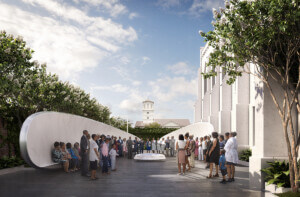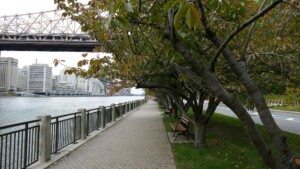A handful of states are home to trees that can claim bona fide arboreal celebrity status, whether they’re very old, very tall, very photogenic, or have played an outsized role in American history. Massachusetts has the Endicott Pear Tree, Louisiana has the Seven Sisters Oak, Georgia has the Jackson Oak, and California has a veritable mini-forest of famous woody specimens. In South Carolina, the most well-known single tree is the Angel Oak, a majestic and positively massive southern live oak on Johns Island, Charleston County, that stands over 66 feet tall and measures 28 feet in circumference. In total, the shade produced by the mighty “Lowcountry Treasure” covers a staggering 17,000 square feet. The colossal tree, acquired by the City of Charleston in 1991 and billed as a historical site, is estimated to be anywhere between 400 and 500 years old.
Once-endangered (more on that in a bit), Angel Oak serves as the crowd-drawing centerpiece of a 9-acre namesake Johns Island park operated by the City of Charleston. In the future, Angel Oak will be further protected within a 35-acre nature preserve surrounding the park that, as announced this week, will be shaped by Nelson Byrd Woltz Landscape Architects. As detailed in a press release from South Carolina conservation nonprofit Lowcountry Land Trust, the award-winning firm, which maintains office in New York City, Huston, and Charlottesville, Virginia, will lead a comprehensive planning process for the planned Angel Oak Preserve. The process is set to commence this summer and include a series of public meetings, surveys, and more with the goal of producing a finalized design early next year.
In a statement, Ashley Demosthenes, president and CEO of the Lowcountry Land Trust, praised Nelson Byrd Woltz for its “unique ability to connect people to each other and to special places through artful, intentional design.”
“The Angel Oak is truly a natural wonder,” said Thomas Woltz, principal of Nelson Byrd Woltz, in a statement released by the firm.
“We are humbled by the opportunity to be a thought partner for the Lowcountry Land Trust and the regional community in protecting the powerful energy of this place,” he added. “And we are excited by the opportunity to bring our tools of design to reveal the stories of the communities that support the Angel Oak.”
As detailed by the Trust, the preserve is envisioned as a “passive, publicly accessible green space that conserves and enhances the Angel Oak’s integrity and surrounding ecosystem; creates a consolidated use of the park and preserves across protected property boundaries; honors the rural and cultural context of the land; and provides a grounding, meaningful experience for all visitors.” Planned features include boardwalk trails, restroom facilities, and integrated educational information about the preserve’s iconic live oak as well as South Carolina’s Sea Islands. A new parking lot will also be designed to reduce traffic flow in the largely rural area and minimize compaction on the tree’s gargantuan root system.
The announcement that Nelson Byrd Woltz will helm the planning process comes as a milestone event following a decade of grassroots activism led by Samantha Siegel, a local resident and project manager for the Lowcountry Land Trust. In 2008, she rallied the community and brought to together allies to stave off a Charleston City Council-approved mixed-use development scheme on Johns Island—the rapidly growing island is the largest in South Carolina and partially located/zoned within Charleston city limits—that would have put Angel Oak at risk and destroyed countless acres of wetlands and inland forest. Initially a largely regional movement, Siegel’s Save Angel Oak campaign to halt the 600-home development eventually morphed into an international-in-scope crusade to buy the threatened land and protect it in perpetuity. The Angel Oak Effect, a Trust-led fundraising campaign launched to help make this happen, raised $7 million in contributions from more than 12,000 donors.
“The grassroots effort to save this magnificent live oak, and the surrounding ecosystem, speaks to the power of nature to capture our collective imagination, bringing us together in service of a higher calling,” said Woltz.
Joining Nelson Byrd Woltz in the planning stages is Charleston-based Robinson Engineering, while the larger preserve project is being steered by a small army of local stakeholders and community members that includes, in addition to the Lowcountry Land Trust staff and board, the Avery Center, Coastal Conservation League, the residents of Johns Island, the City of Charleston, Charleston Parks Conservancy, Gullah/Geechee Nation, the Town of Kiawah, and The Progressive Club.
Further updates and info can be found here.











